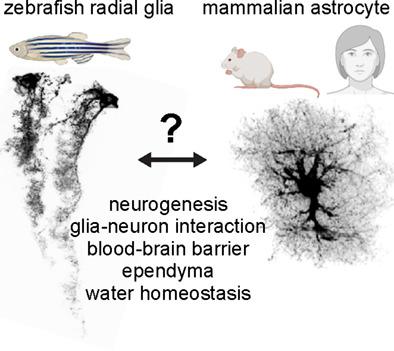Our official English website, www.x-mol.net, welcomes your feedback! (Note: you will need to create a separate account there.)
Radial glia in the zebrafish brain: Functional, structural, and physiological comparison with the mammalian glia.
Glia ( IF 6.2 ) Pub Date : 2020-05-31 , DOI: 10.1002/glia.23849 Nathalie Jurisch-Yaksi 1, 2, 3 , Emre Yaksi 1 , Caghan Kizil 4, 5
Glia ( IF 6.2 ) Pub Date : 2020-05-31 , DOI: 10.1002/glia.23849 Nathalie Jurisch-Yaksi 1, 2, 3 , Emre Yaksi 1 , Caghan Kizil 4, 5
Affiliation

|
The neuroscience community has witnessed a tremendous expansion of glia research. Glial cells are now on center stage with leading roles in the development, maturation, and physiology of brain circuits. Over the course of evolution, glia have highly diversified and include the radial glia, astroglia or astrocytes, microglia, oligodendrocytes, and ependymal cells, each having dedicated functions in the brain. The zebrafish, a small teleost fish, is no exception to this and recent evidences point to evolutionarily conserved roles for glia in the development and physiology of its nervous system. Due to its small size, transparency, and genetic amenability, the zebrafish has become an increasingly prominent animal model for brain research. It has enabled the study of neural circuits from individual cells to entire brains, with a precision unmatched in other vertebrate models. Moreover, its high neurogenic and regenerative potential has attracted a lot of attention from the research community focusing on neural stem cells and neurodegenerative diseases. Hence, studies using zebrafish have the potential to provide fundamental insights about brain development and function, and also elucidate neural and molecular mechanisms of neurological diseases. We will discuss here recent discoveries on the diverse roles of radial glia and astroglia in neurogenesis, in modulating neuronal activity and in regulating brain homeostasis at the brain barriers. By comparing insights made in various animal models, particularly mammals and zebrafish, our goal is to highlight the similarities and differences in glia biology among species, which could set new paradigms relevant to humans.
中文翻译:

斑马鱼大脑中的径向神经胶质:与哺乳动物神经胶质的功能、结构和生理比较。
神经科学界见证了神经胶质研究的巨大扩展。神经胶质细胞现在处于中心舞台,在大脑回路的发育、成熟和生理学中起主导作用。在进化过程中,神经胶质高度多样化,包括放射状胶质细胞、星形胶质细胞或星形胶质细胞、小胶质细胞、少突胶质细胞和室管膜细胞,每个细胞在大脑中都有专门的功能。斑马鱼是一种小型硬骨鱼,也不例外,最近的证据表明神经胶质在其神经系统的发育和生理学中具有进化上保守的作用。由于其体积小、透明度高和遗传适应性强,斑马鱼已成为越来越突出的大脑研究动物模型。它使研究从单个细胞到整个大脑的神经回路成为可能,具有其他脊椎动物模型无法比拟的精度。此外,其高神经源性和再生潜力引起了神经干细胞和神经退行性疾病研究界的广泛关注。因此,使用斑马鱼的研究有可能提供有关大脑发育和功能的基本见解,并阐明神经系统疾病的神经和分子机制。我们将在这里讨论最近关于径向胶质细胞和星形胶质细胞在神经发生、调节神经元活动和调节脑屏障处的脑稳态方面的不同作用的发现。通过比较在各种动物模型(尤其是哺乳动物和斑马鱼)中获得的见解,我们的目标是突出物种之间神经胶质生物学的异同,这可以为人类设定新的范式。
更新日期:2020-05-31
中文翻译:

斑马鱼大脑中的径向神经胶质:与哺乳动物神经胶质的功能、结构和生理比较。
神经科学界见证了神经胶质研究的巨大扩展。神经胶质细胞现在处于中心舞台,在大脑回路的发育、成熟和生理学中起主导作用。在进化过程中,神经胶质高度多样化,包括放射状胶质细胞、星形胶质细胞或星形胶质细胞、小胶质细胞、少突胶质细胞和室管膜细胞,每个细胞在大脑中都有专门的功能。斑马鱼是一种小型硬骨鱼,也不例外,最近的证据表明神经胶质在其神经系统的发育和生理学中具有进化上保守的作用。由于其体积小、透明度高和遗传适应性强,斑马鱼已成为越来越突出的大脑研究动物模型。它使研究从单个细胞到整个大脑的神经回路成为可能,具有其他脊椎动物模型无法比拟的精度。此外,其高神经源性和再生潜力引起了神经干细胞和神经退行性疾病研究界的广泛关注。因此,使用斑马鱼的研究有可能提供有关大脑发育和功能的基本见解,并阐明神经系统疾病的神经和分子机制。我们将在这里讨论最近关于径向胶质细胞和星形胶质细胞在神经发生、调节神经元活动和调节脑屏障处的脑稳态方面的不同作用的发现。通过比较在各种动物模型(尤其是哺乳动物和斑马鱼)中获得的见解,我们的目标是突出物种之间神经胶质生物学的异同,这可以为人类设定新的范式。


























 京公网安备 11010802027423号
京公网安备 11010802027423号